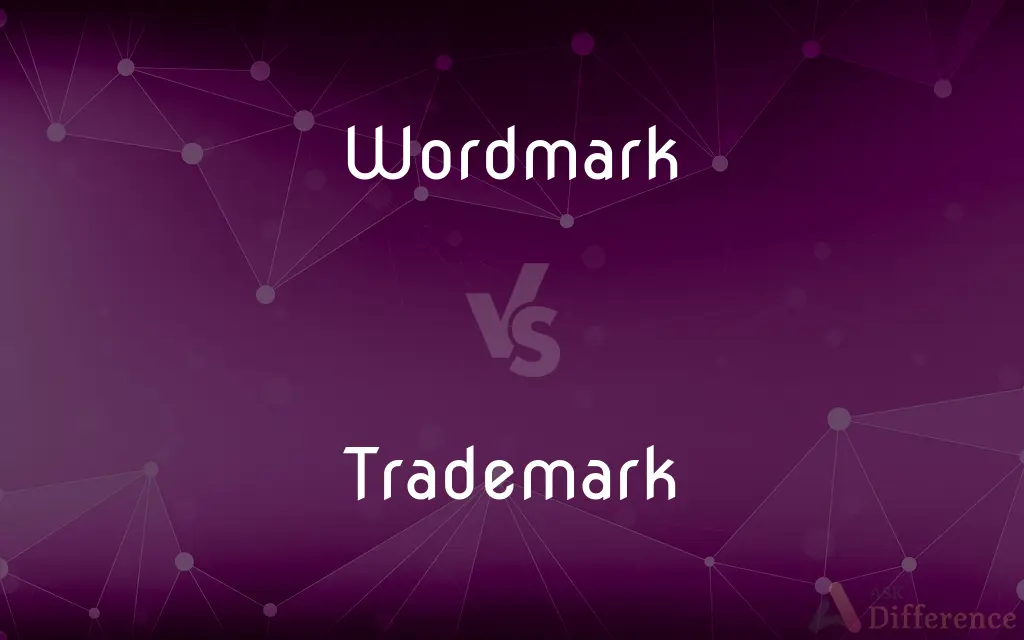Wordmark vs. Trademark — What's the Difference?
By Fiza Rafique & Urooj Arif — Updated on March 27, 2024
A wordmark is a distinct text-only typographic treatment of a name, while a trademark protects brand identity through legal means.

Difference Between Wordmark and Trademark
Table of Contents
ADVERTISEMENT
Key Differences
A wordmark is specifically a type of logo that consists solely of text — the name of a company, product, or service styled in a unique way to ensure brand recognition. This text-based design focuses on typography, color, and style to create a memorable brand identity. Famous examples include the Coca-Cola and Google logos, which are instantly recognizable by their distinctive fonts and colors. On the other hand, a trademark is a legal designation that can protect not just a wordmark but also symbols, names, phrases, logos, and other elements that identify and distinguish a brand or product in the marketplace. Trademarks are registered with a governmental or official institution and provide legal protection against infringement, preventing others from using a similar mark that could cause confusion.
Wordmarks rely heavily on design elements to convey a brand's essence and personality through typography. This requires careful consideration of font choice, size, color, and sometimes additional graphic elements to ensure the wordmark effectively communicates the brand's message and stands out in a crowded marketplace. Trademarks, while they can include wordmarks, encompass a broader range of brand identifiers. Registration of a trademark grants the owner exclusive rights to use it in connection with the goods or services listed in the registration, across the entire jurisdiction where the trademark is registered. This is crucial for brand protection and helps to maintain a company's reputation by ensuring that only they can use their distinctive marks.
Wordmarks are an essential part of a brand's visual identity and are often used in marketing and advertising to build brand recognition. They need to be distinctive and memorable to effectively capture the essence of the brand they represent, making them a critical tool in brand strategy. Trademarks, through their legal protection, support the efforts of branding by ensuring that a company's identity and reputation are safeguarded. They are an integral part of a brand's overall strategy, providing a framework within which a company can operate securely, knowing that their brand identity is protected from misuse or imitation.
In the creative process, designers focus on the aesthetic and communicative aspects of a wordmark to ensure it aligns with the brand’s values and target audience. This involves a deep understanding of typography and design trends to create a wordmark that is both timeless and effective in conveying the brand’s message.
Legal professionals, on the other hand, navigate the complexities of trademark law to secure and defend trademarks. The process involves researching existing trademarks, preparing and filing the necessary documentation, and possibly engaging in legal action to enforce trademark rights. This dual approach of creative design and legal protection is essential for building and maintaining a strong brand presence in the market.
ADVERTISEMENT
Comparison Chart
Definition
Text-only typographic treatment of a name.
Legal protection for brand identifiers.
Focus
Design and typography.
Legal rights and brand protection.
Examples
Coca-Cola, Google logos.
Logo, slogan, brand name.
Purpose
Create memorable brand identity.
Prevent unauthorized use of brand elements.
Protection
None inherently, but can be trademarked.
Granted through registration.
Compare with Definitions
Wordmark
A uniquely styled text logo of a company's name.
The elegant wordmark of Tiffany & Co. is recognized worldwide.
Trademark
Involves a formal process and legal documentation.
Trademarking a brand name ensures exclusive rights to its use in business.
Wordmark
Designed to be instantly recognizable.
The FedEx wordmark cleverly hides an arrow in its negative space.
Trademark
Can cover names, symbols, and even colors.
Tiffany Blue is a trademarked color by Tiffany & Co.
Wordmark
Typography and color to ensure brand recognition.
Adobe’s wordmark is notable for its simple, clean typography.
Trademark
Prevents others from using similar identifiers.
Apple's trademark on the apple logo and name protects its brand identity.
Wordmark
Primarily in branding and visual identity.
The unique wordmark of Google is a fundamental part of its brand.
Trademark
A legal designation protecting a brand's unique elements.
The Nike swoosh is a globally recognized trademark.
Wordmark
Involves selecting the right typeface and customizing it.
The Disney wordmark's distinctive script font conveys a sense of whimsy.
Trademark
Trademark owners can take legal action against infringement.
Counterfeit products using a trademarked logo can lead to lawsuits.
Wordmark
A wordmark, word mark, or logotype is usually a distinct text-only typographic treatment of the name of a company, institution, or product name used for purposes of identification and branding. Examples can be found in the graphic identities of the Government of Canada, FedEx, Microsoft, and IBM. The organization name is incorporated as a simple graphic treatment to create a clear, visually memorable identity.
Trademark
A trademark (also written trade mark or trade-mark) is a type of intellectual property consisting of a recognizable sign, design, or expression which identifies products or services of a particular source from those of others, although trademarks used to identify services are usually called service marks. The trademark owner can be an individual, business organization, or any legal entity.
Wordmark
A trademark consisting of a word or text sequence used to identify a company or product, for example.
Trademark
A symbol, word, or words legally registered or established by use as representing a company or product.
Wordmark
(marketing) A logotype; a standardized graphic representation of the name of a company or product used for purposes of easy identification. It is is often text with unique typographic or graphical treatment.
Trademark
Provide with a trademark
They are counterfeiting trademarked goods
Wordmark
(computing) A bit in each memory location on some variable-word-length computers (e.g. IBM 1401, IBM 1620) used to mark the end of a word.
Trademark
Abbr. TM A name, symbol, or other device used to identify and promote a product or service, especially an officially registered name or symbol that is thereby protected against use by others.
Trademark
A distinctive characteristic by which a person or thing comes to be known
The snicker that became the comedian's trademark.
Trademark
To label (a product) with proprietary identification.
Trademark
To register (something) as a trademark.
Trademark
A word, symbol, or phrase used to identify a particular company's product and differentiate it from other companies' products.
Trademark
Any proprietary business, product or service name.
Trademark
The aspect for which someone or something is best known; a hallmark or typical characteristic.
Trademark
(proscribed) To register something as a trademark.
Trademark
(proscribed) To so label a product.
Trademark
(informal) Distinctive, characteristic, signature.
Trademark
A distinctive characteristic or attribute
Trademark
A formally registered symbol identifying the manufacturer or distributor of a product
Common Curiosities
Can a wordmark be trademarked?
Yes, a wordmark can be trademarked to secure exclusive rights to its use in the marketplace.
Why is typography important in a wordmark?
Typography in a wordmark is crucial because it conveys the brand’s personality and values, and ensures the brand is easily recognizable.
What is a wordmark?
A wordmark is a specific type of logo made up of text, usually a business or product name, designed in a unique way to establish brand identity.
How does a trademark protect a business?
Trademarks protect a business by legally preventing others from using similar signs that could confuse consumers, ensuring brand integrity.
Can a wordmark work for any brand?
While a wordmark can be effective for many brands, its success depends on the brand’s name and the quality of the typographic design.
What is a trademark?
A trademark is a legal mechanism that protects brand elements like logos, names, and slogans from being used without permission.
What happens if a trademark is infringed?
If a trademark is infringed, the trademark owner can take legal action to stop the unauthorized use and possibly seek damages.
What can be trademarked?
Names, logos, slogans, and sometimes colors and sounds that uniquely identify a brand can be trademarked.
What is the process for registering a trademark?
Registering a trademark involves searching existing trademarks, filing an application, and sometimes a legal review to ensure the mark is unique and eligible for protection.
Is a logo or a wordmark better for a new business?
The choice between a logo and a wordmark depends on the business’s branding strategy, though a simple, strong wordmark is often a good start for clarity and recognition.
How long does trademark protection last?
Trademark protection lasts as long as the trademark is in use and properly renewed, which can be indefinitely.
Do all countries recognize trademarks the same way?
While trademark laws are generally similar, the process and extent of protection can vary by country, requiring registration in each country where protection is sought.
Share Your Discovery

Previous Comparison
Dreadlocks vs. Cornrows
Next Comparison
Across vs. ThroughAuthor Spotlight
Written by
Fiza RafiqueFiza Rafique is a skilled content writer at AskDifference.com, where she meticulously refines and enhances written pieces. Drawing from her vast editorial expertise, Fiza ensures clarity, accuracy, and precision in every article. Passionate about language, she continually seeks to elevate the quality of content for readers worldwide.
Co-written by
Urooj ArifUrooj is a skilled content writer at Ask Difference, known for her exceptional ability to simplify complex topics into engaging and informative content. With a passion for research and a flair for clear, concise writing, she consistently delivers articles that resonate with our diverse audience.
















































